PCI
来源:互联网 发布:youtube电脑软件下载 编辑:程序博客网 时间:2024/05/17 01:19
Chapter 6
PCI

Peripheral Component Interconnect (PCI), as its name implies is a standard that describes how to connectthe peripheral components of a system together in a structuredand controlled way.The standard describes the way that the system components are electricallyconnected and the way that they should behave.This chapter looks at how the Linux kernel initializes the system's PCIbuses and devices.

Figure 6.1 is a logical diagram of an example PCI based system.The PCI buses and PCI-PCI bridges are the glue connecting the systemcomponents together; the CPU is connected to PCI bus 0, the primary PCI bus as is the video device. A special PCI device, a PCI-PCI bridge connects the primarybus to the secondary PCI bus, PCI bus 1. In the jargon of the PCI specification, PCI bus 1 is described as beingdownstream of the PCI-PCI bridge andPCI bus 0 is up-stream of the bridge.Connected to the secondary PCI bus are the SCSI and ethernetdevices for the system.Physically the bridge, secondary PCI bus and two deviceswould all be contained on the same combination PCI card.The PCI-ISA bridge in the system supports older, legacy ISA devices and the diagramshows a super I/O controller chip, which controls the keyboard, mouse andfloppy.1
6.1 PCI Address Spaces
The CPU and the PCI devices need to access memory that is sharedbetween them.This memory is used by device drivers to control the PCI devices andto pass information between them.Typically the shared memory contains control and status registers for thedevice.These registers are used to control the device and to read its status.For example, the PCI SCSI device driver would read its status registerto find out if the SCSI device was ready to write a block of informationto the SCSI disk.Or it might write to the control register to start the device running after ithas been turned on.
The CPU's system memory could be used for this shared memory but if it were, then every time a PCI device accessed memory, the CPU would have to stall, waiting forthe PCI device to finish.Access to memory is generally limited to one system component at a time.This would slow the system down.It is also not a good idea to allow the system's peripheral devices toaccess main memory in an uncontrolled way.This would be very dangerous; a rogue device could make the systemvery unstable.
Peripheral devices have their own memory spaces.The CPU can access these spaces but access by the devices into thesystem's memory is very strictly controlled using DMA (Direct MemoryAccess) channels.ISA devices have access to two address spaces, ISA I/O (Input/Output) and ISA memory.PCI has three; PCI I/O, PCI Memory and PCI Configuration space.All of these address spaces are also accessible by the CPU with thethe PCI I/O and PCI Memory address spaces being used by the devicedrivers and the PCI Configuration space being used by the PCI initializationcode within the Linux kernel.
The Alpha AXP processor does not have natural access to addresses spaces other thanthe system address space.It uses support chipsets to access other address spaces such as PCI Configurationspace.It uses a sparse address mapping scheme which steals part of the large virtual address space and maps it to the PCI address spaces.
6.2 PCI Configuration Headers
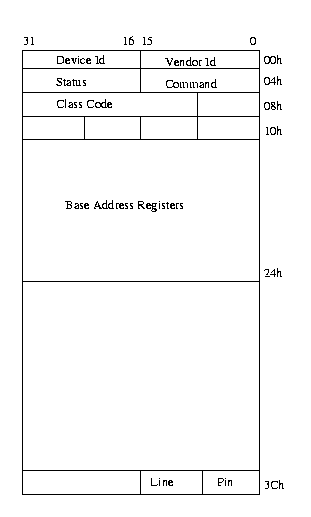
Every PCI device in the system, including the PCI-PCI bridgeshas a configuration data structure that is somewhere inthe PCI configuration address space.The PCI Configuration header allows the system to identify andcontrol the device.Exactly where the header is in the PCI Configuration address spacedepends on where in the PCI topology that device is.For example, a PCI video card plugged into one PCI slot on the PC motherboard will have its configuration header at one location and if it isplugged into another PCI slot then its header will appear in another location in PCI Configuration memory.This does not matter, for wherever the PCI devices and bridgesare the system will find and configure them using the statusand configuration registers in their configuration headers.
Typically, systems are designed so that every PCI slot has it's PCI Configuration Header in an offset that is related toits slot on the board. So, for example, the first slot on the board might have itsPCI Configuration at offset 0 and the second slot at offset256 (all headers are the same length, 256 bytes) and so on.A system specific hardware mechanism is defined so that the PCI configuration code can attempt to examine all possible PCI ConfigurationHeaders for a given PCI bus and know which devices are presentand which devices are absent simply by trying to read one ofthe fields in the header (usually theVendor Identificationfield) and getting some sort of error.The describesone possible error message as returning0xFFFFFFFF when attempting toread the Vendor Identification andDevice Identification fields for an empty PCI slot.
Figure 6.2 shows the layoutof the 256 byte PCI configuration header. It contains the following fields:
- Vendor Identification
- A unique number describing the originatorof the PCI device. Digital's PCI Vendor Identification is0x1011 and Intel's is0x8086.
- Device Identification
- A unique number describingthe device itself. For example, Digital's 21141 fastethernet device has a device identification of0x0009.
- Status
- This field gives the status of thedevice with the meaning of the bits of this field setby the standard. .
- Command
- By writing to this field the systemcontrols the device, for example allowing the device to access PCI I/O memory,
- Class Code
- This identifies the type of device thatthis is. There are standard classes for every sort of device;video, SCSI and so on. The class code for SCSI is0x0100.
- Base Address Registers
- These registers are used todetermine and allocate the type, amount and location ofPCI I/O and PCI memory space that the device can use.
- Interrupt Pin
- Four of the physical pins on the PCI card carryinterrupts from the card to the PCI bus. The standard labels these asA, B, C and D. TheInterrupt Pin field describes which of these pins this PCI device uses. Generally it is hardwired for a pariticulardevice. That is, every time the system boots, the device uses the sameinterrupt pin. This information allows the interrupt handling subsystemto manage interrupts from this device,
- Interrupt Line
- The Interrupt Line field of the device's PCI Configuration headeris used to pass an interrupt handle between the PCI initialisation code, the device's driver and Linux's interrupt handling subsystem.The number written there is meaningless to the the device driver but itallows the interrupt handler to correctly route an interrupt from thePCI device to the correct device driver's interrupt handling code withinthe Linux operating system.See Chapter interrupt-chapter on page for details on how Linux handles interrupts.
6.3 PCI I/O and PCI Memory Addresses
These two address spaces are used by the devices to communicatewith their device drivers running in the Linux kernel on the CPU.For example, the DECchip 21141 fast ethernet device maps itsinternal registers into PCI I/O space.Its Linux device driver then reads and writes those registers to controlthe device.Video drivers typically use large amounts of PCI memory spaceto contain video information.
Until the PCI system has been set up and the device's access tothese address spaces has been turned on using theCommand field in the PCI Configuration header, nothing can access them.It should be noted that only the PCI configuration code readsand writes PCI configuration addresses; the Linux device drivers only read and write PCI I/O and PCI memory addresses.
6.4 PCI-ISA Bridges
These bridges support legacy ISA devices by translating PCI I/O and PCI Memoryspace accesses into ISA I/O and ISA Memory accesses.A lot of systems now sold contain several ISA bus slots and several PCI bus slots.Over time the need for this backwards compatibility will dwindle and PCI onlysystems will be sold.Where in the ISA address spaces (I/O and Memory) the ISA devices of thesystem have their registers was fixed in the dim mists of time by theearly Intel 8080 based PCs.Even a $5000 Alpha AXP based computer systems will have its ISA floppy controllerat the same place in ISA I/O space as the first IBM PC.The PCI specification copes with this by reserving the lower regionsof the PCI I/O and PCI Memory address spaces for use by the ISA peripheralsin the system and using a single PCI-ISA bridge to translate any PCI memoryaccesses to those regions into ISA accesses.6.5 PCI-PCI Bridges
PCI-PCI bridges are special PCI devices that glue the PCI buses of the system together.Simple systems have a single PCI bus but there is anelectrical limit on the number of PCI devices that a singlePCI bus can support.Using PCI-PCI bridges to add more PCI buses allows the systemto support many more PCI devices.This is particularly important for a high performance server.Of course, Linux fully supports the use of PCI-PCI bridges.
6.5.1 PCI-PCI Bridges: PCI I/O and PCI Memory Windows
PCI-PCI bridges only pass a subset of PCI I/O and PCI memory read and write requests downstream.For example, in Figure 6.1 on page pageref, the PCI-PCI bridge will only pass read and write addresses from PCI bus 0 to PCI bus 1if they are for PCI I/O or PCI memory addresses owned by either the SCSI or ethernet device; all other PCI I/O and memory addresses are ignored.This filtering stops addresses propogating needlessly throughout the system.To do this, the PCI-PCI bridges must be programmed with a base and limit for PCI I/O and PCI Memory space access that they have to pass from their primary bus onto their secondary bus. Once the PCI-PCI Bridges in a system have been configured then so long as the Linux device drivers only access PCI I/O and PCI Memory space via these windows, the PCI-PCI Bridges are invisible.This is an important feature that makes life easier for Linux PCI device driver writers.However, it also makes PCI-PCI bridges somewhat tricky forLinux to configure as we shall see later on.6.5.2 PCI-PCI Bridges: PCI Configuration Cycles and PCI Bus Numbering


So that the CPU's PCI initialization code can address devices that are not on the main PCI bus, there has to be a mechanism that allows bridges to decide whether or not to pass Configuration cycles from their primary interface to their secondary interface.A cycle is just an address as it appears on the PCI bus. The PCI specification defines two formats for the PCI Configuration addresses; Type 0 and Type 1; theseare shown in Figure 6.3 and Figure 6.4respectively.Type 0 PCI Configuration cycles do not contain a bus number and these areinterpretted by all devices as being for PCI configuration addresses on this PCI bus.Bits 31:11 of the Type 0 configuraration cycles are treated as thedevice select field.One way to design a system is to have each bit select a different device.In this case bit 11 would select the PCI device in slot 0, bit 12 wouldselect the PCI device in slot 1 and so on.Another way is to write the device's slot number directly into bits 31:11.Which mechanism is used in a system depends on the system's PCI memory controller.
Type 1 PCI Configuration cycles contain a PCI bus number and this typeof configuration cycle is ignored by all PCI devices except the PCI-PCIbridges.All of the PCI-PCI Bridges seeing Type 1 configuration cycles may chooseto pass them to the PCI buses downstream of themselves.Whether the PCI-PCI Bridge ignores the Type 1 configuration cycle orpasses it onto the downstream PCI bus depends on how the PCI-PCI Bridge has been configured.Every PCI-PCI bridge has a primary bus interface number and a secondary bus interface number.The primary bus interface being the one nearest the CPU and the secondarybus interface being the one furthest away.Each PCI-PCI Bridge also has a subordinate bus number and this isthe maximum bus number of all the PCI buses that are bridged beyond the secondary bus interface.Or to put it another way, the subordinate bus number isthe highest numbered PCI bus downstream of the PCI-PCI bridge.When the PCI-PCI bridge sees a Type 1 PCI configuration cycle it does one of the following things:
- Ignore it if the bus number specified is not in between the bridge's secondary bus number and subordinate bus number (inclusive),
- Convert it to a Type 0 configuration command if the bus number specified matches the secondary bus number of the bridge,
- Pass it onto the secondary bus interface unchanged if the bus number specified is greater than the secondary bus number and less than or equal to the subordinate bus number.
So, if we want to address Device 1 on bus 3 of the topology Figure pci-pci-config-eg-4 on page we must generate a Type 1 Configuration command from the CPU. Bridge1 passes this unchanged onto Bus 1. Bridge2 ignores it but Bridge3 converts it into a Type 0 Configuration command and sends it out on Bus 3 where Device 1 responds to it.
It is up to each individual operating system to allocate bus numbers during PCI configuration but whatever the numbering scheme used the following statement must be true for all of the PCI-PCI bridges in the system:
``All PCI buses located behind a PCI-PCI bridge must reside between the seondary bus number and the subordinate bus number (inclusive).''
If this rule is broken then the PCI-PCI Bridges will not pass andtranslate Type 1 PCI configuration cycles correctly and the system willfail to find and initialise the PCI devices in the system.To achieve this numbering scheme, Linux configures these special devices in a particular order. Section pci-pci-bus-numbering on page describes Linux's PCI bridge and bus numbering scheme in detail togetherwith a worked example.
6.6 Linux PCI Initialization
The PCI initialisation code in Linux is broken into three logical parts:
- PCI Device Driver
- This pseudo-device driver searches thePCI system starting at Bus 0 and locates all PCIdevices and bridges in the system. It builds a linked list of data structures describing the topology of the system.Additionally, it numbers all of the bridges that it finds.
- PCI BIOS
- This software layer provides the servicesdescribed in bib-pci-bios-specification. Even though Alpha AXP doesnot have BIOS services, there is equivalent code in the Linuxkernel providing the same functions,
- PCI Fixup
- System specific fixup code tidies up thesystem specific loose ends of PCI initialization.
6.6.1 The Linux Kernel PCI Data Structures
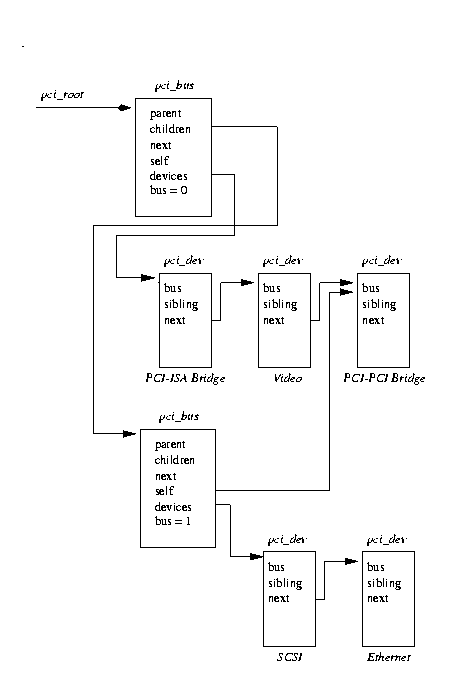
As the Linux kernel initialises the PCI system it builds data structures mirroringthe real PCI topology of the system.Figure 6.5 shows the relationships of the data structuresthat it would build for the example PCI system in Figure 6.1on page pageref.
Each PCI device (including the PCI-PCI Bridges) is described by a pci_dev datastructure.Each PCI bus is described by apci_bus data structure.The result is a tree structure of PCI buses each of which has a number ofchild PCI devices attached to it.As a PCI bus can only be reached using a PCI-PCI Bridge (except the primary PCI bus, bus 0),eachpci_bus contains a pointer to the PCI device (the PCI-PCI Bridge) that it is accessed through.That PCI device is a child of the the PCI Bus's parent PCI bus.
Not shown in the Figure 6.5 is a pointer to all of the PCI devices in the system,pci_devices.All of the PCI devices in the system have their pci_dev data structures queued ontothis queue..This queue is used by the Linux kernel to quickly find all of the PCI devices in the system.
6.6.2 The PCI Device Driver
The PCI device driver is not really a device driver at all buta function of the operating system called at system initialisation time.The PCI initialisation code must scan all of the PCI buses in the system looking for all PCI devices in the system (includingPCI-PCI bridge devices).
It uses the PCI BIOS code to find out if every possible slot in thecurrent PCI bus that it is scanning is occupied.If the PCI slot is occupied, it builds apci_dev data structure describing the device and links into the list of known PCI devices (pointed at bypci_devices).
The PCI initialisation code starts by scanning PCI Bus 0.It tries to read the Vendor Identification and Device Identificationfields for every possible PCI device in every possible PCI slot.When it finds an occupied slot it builds apci_dev data structuredescribing the device.All of the pci_dev data structures built by the PCI initialisation code (including all of the PCI-PCI Bridges) are linked into a singly linkedlist;pci_devices.
If the PCI device that was found was a PCI-PCI bridge then a pci_busdata structure is built and linked into the tree ofpci_bus andpci_dev data structures pointed at by pci_root.The PCI initialisation code can tell if the PCI device is a PCI-PCI Bridgebecause it has a class code of0x060400.The Linux kernel then configures the PCI bus on the other (downstream) sideof the PCI-PCI Bridge that it has just found.If more PCI-PCI Bridges are found then these are also configured.This process is known as a depthwise algorithm; the system's PCItopology is fully mapped depthwise before searching breadthwise.Looking at Figure 6.1 on page pageref,Linux would configure PCI Bus 1 with its Ethernet and SCSI device before itconfigured the video device on PCI Bus 0.
As Linux searches for downstream PCI buses it must also configure the intervening PCI-PCI bridges' secondary and subordinate bus numbers. This is described in detail in Section pci-pci-bus-numbering below.
Configuring PCI-PCI Bridges - Assigning PCI Bus Numbers
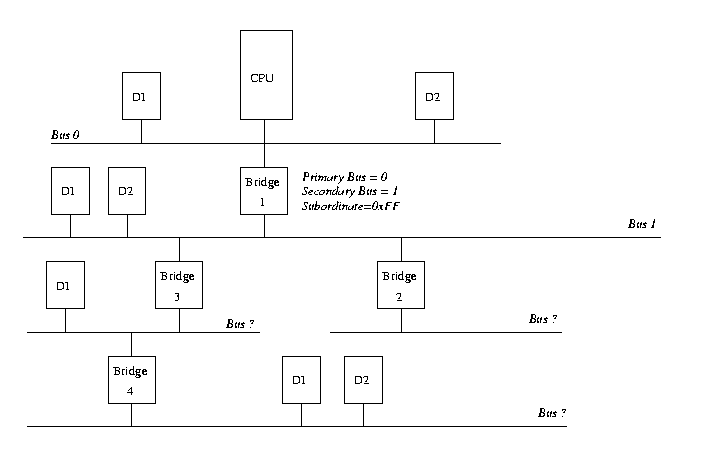
For PCI-PCI bridges to pass PCI I/O, PCI Memory or PCI Configuration address space reads and writes across them, they need to know the following:
- Primary Bus Number
- The bus number immediatelyupstream of the PCI-PCI Bridge,
- Secondary Bus Number
- The bus number immediatelydownstream of the PCI-PCI Bridge,
- Subordinate Bus Number
- The highest bus number of allof the buses that can be reached downstream of the bridge.
- PCI I/O and PCI Memory Windows
- The window base and size for PCI I/O address space and PCI Memory address space for all addresses downstream of the PCI-PCI Bridge.
The problem is that at the time when you wish to configure any given PCI-PCI bridge you do not know the subordinate bus number for that bridge. You do not know if there are further PCI-PCI bridges downstream and if you did, you do not know what numbers will be assigned to them.The answer is to use a depthwise recursive algorithmand scan each bus for any PCI-PCI bridges assigning them numbers as they are found. As each PCI-PCI bridge is found and its secondary bus numbered, assign it a temporary subordinate number of 0xFF and scan and assign numbers to all PCI-PCI bridges downstream of it. This all seems complicated but the worked example below makes this processclearer.
- PCI-PCI Bridge Numbering: Step 1
- Taking the topology in Figure 6.6, the first bridgethe scan would find is Bridge1. The PCI bus downstream of Bridge1 would be numbered as 1 and Bridge1 assigned a secondary bus number of 1 and a temporary subordinate bus number of0xFF. This means that all Type 1 PCI Configuration addresses specifying a PCI bus numberof 1 or higher would be passed across Bridge1 and onto PCI Bus 1.They would be translated into Type 0 Configuration cycles if they have a bus numberof 1 but left untranslated for all other bus numbers.This is exactly what the Linux PCI initialisation code needs to do in order to go and scan PCI Bus 1.
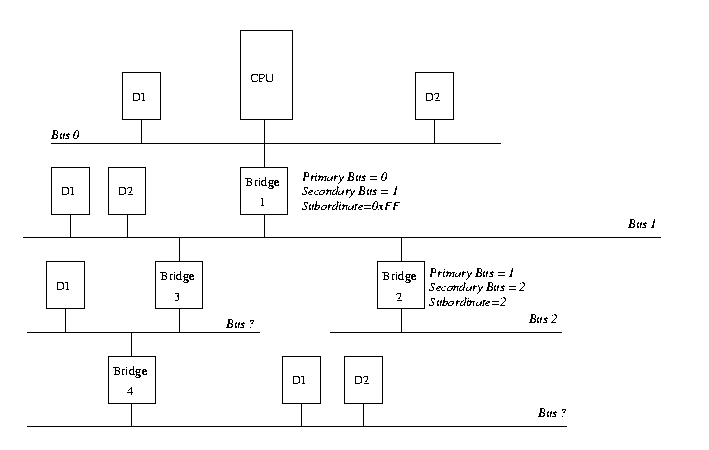
Figure 6.7: Configuring a PCI System: Part 2 - PCI-PCI Bridge Numbering: Step 2
- Linux uses a depthwise algorithm and so the initialisation code goeson to scan PCI Bus 1.Here it finds PCI-PCI Bridge2. There are no further PCI-PCI bridges beyond PCI-PCI Bridge2, so it is assigned a subordinate bus number of 2 which matches the number assigned to its secondary interface. Figure 6.7 shows how the buses andPCI-PCI bridges are numbered at this point.
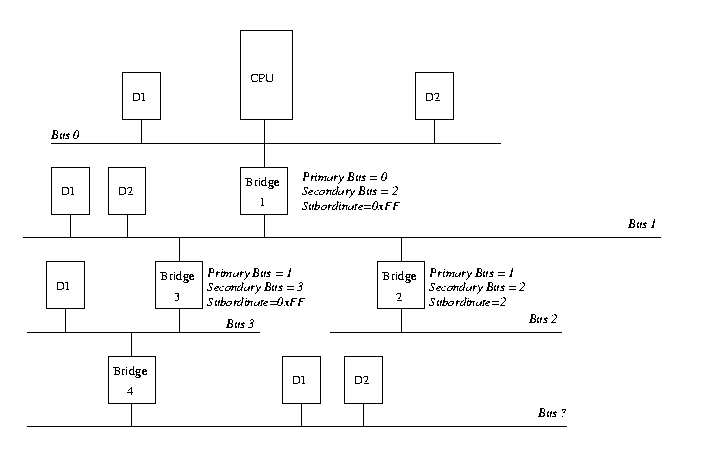
Figure 6.8: Configuring a PCI System: Part 3 - PCI-PCI Bridge Numbering: Step 3
- The PCI initialisation code returns to scanning PCI Bus 1 and finds another PCI-PCI bridge, Bridge3.It is assigned 1 as its primary bus interface number, 3 as its secondary bus interface number and0xFF as its subordinate bus number.Figure 6.8 on page pageref shows how the system is configured now.Type 1 PCI configuration cycles with a bus number of 1, 2 or 3 wil be correctlydelivered to the appropriate PCI buses.
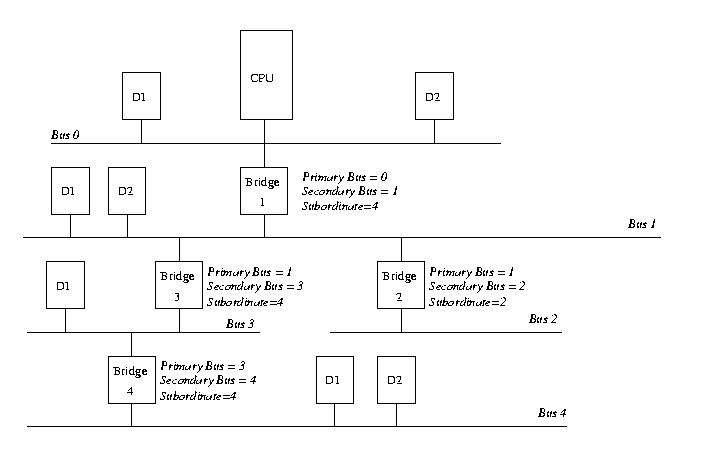
Figure 6.9: Configuring a PCI System: Part 4 - PCI-PCI Bridge Numbering: Step 4
- Linux starts scanning PCI Bus 3, downstream of PCI-PCI Bridge3.PCI Bus 3 has another PCI-PCI bridge (Bridge4) on it, it is assigned 3 as itsprimary bus number and 4 as its secondary bus number.It is the last bridge on this branch and so it is assigned a subordinate businterface number of 4.The initialisation code returns to PCI-PCI Bridge3 and assigns it asubordinate bus number of 4.Finally, the PCI initialisation code can assign 4 as the subordinate bus number for PCI-PCI Bridge1.Figure 6.9 on page pageref shows the final bus numbers.
6.6.3 PCI BIOS Functions
The PCI BIOS functions are a series of standard routines which are commonacross all platforms.For example, they are the same for both Intel and Alpha AXP based systems.They allow the CPU controlled access to all of the PCI address spaces.
Only Linux kernel code and device drivers may use them.
6.6.4 PCI Fixup
The PCI fixup code for Alpha AXP does rather more than that for Intel (whichbasically does nothing).
For Intel based systems the system BIOS, which ran at boot time, has alreadyfully configured the PCI system.This leaves Linux with little to do other than map that configuration.For non-Intel based systems further configuration needs to happen to:
- Allocate PCI I/O and PCI Memory space to each device,
- Configure the PCI I/O and PCI Memory address windows for each PCI-PCI bridge in the system,
- Generate Interrupt Line values for the devices; these control interrupthandling for the device.
The next subsections describe how that code works.
Finding Out How Much PCI I/O and PCI Memory Space a Device Needs
Each PCI device found is queried to find out how much PCI I/O and PCI Memory address space it requires. To do this, each Base Address Register has all 1's written to it and then read. The device will return 0's in the don't-care address bits, effectively specifying the address space required.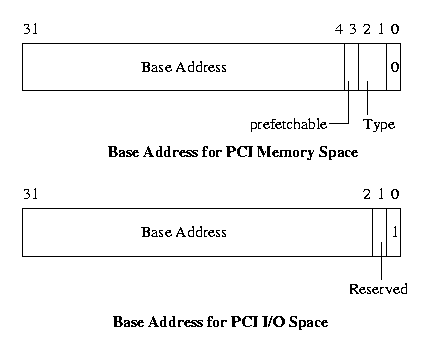
There are two basic types of Base Address Register, the first indicates within which address space the devices registers must reside; either PCI I/O or PCI Memory space. This is indicated by Bit 0 of the register.Figure 6.10 shows the two forms of the Base Address Register for PCI Memory and for PCI I/O.
To find out just how much of each address space a given Base Address Register is requesting, you write all 1s into the register and then read it back. The device will specify zeros in the don't care address bits, effectively specifying the address space required. This design implies that all address spaces used are a power of two and are naturally aligned.
For example when you initialize the DECChip 21142 PCI Fast Ethernet device, it tells you that it needs0x100 bytes of space of either PCI I/O or PCI Memory. The initialization code allocates it space. The moment that it allocates space, the 21142's control and status registers can be seen at those addresses.
Allocating PCI I/O and PCI Memory to PCI-PCI Bridges and Devices
Like all memory the PCI I/O and PCI memory spaces are finite, and to someextent scarce.The PCI Fixup code for non-Intel systems (and the BIOS code for Intelsystems) has to allocate each device the amount of memory that it isrequesting in an efficient manner.Both PCI I/O and PCI Memory must be allocated to a device in a naturally aligned way. For example, if a device asks for0xB0 of PCI I/O space then it must be aligned on an address that is a multiple of0xB0. In addition to this, the PCI I/O and PCI Memory bases for any given bridge must be aligned on 4K and on 1Mbyte boundaries respectively. Given that the address spaces for downstream devices must lie within all of the upstream PCI-PCI Bridge's memory ranges for any given device, it is a somewhat difficult problem to allocate space efficiently.The algorithm that Linux uses relies on each device described by the bus/device tree built by the PCI Device Driver being allocated address space in ascending PCI I/O memory order. Again a recursive algorithm is used to walk thepci_bus and pci_dev data structures built by the PCI initialisation code.Starting at the root PCI bus (pointed at bypci_root) the BIOS fixupcode:
- Aligns the current global PCI I/O and Memory bases on 4K and 1 Mbyte boundaries respectively,
- For every device on the current bus (in ascending PCI I/O memory needs),
- allocates it space in PCI I/O and/or PCI Memory,
- moves on the global PCI I/O and Memory bases by the appropriate amounts,
- enables the device's use of PCI I/O and PCI Memory,
- Allocates space recursively to all of the buses downstream of the current bus. Note that this will change the global PCI I/O and Memory bases,
- Aligns the current global PCI I/O and Memory bases on 4K and 1 Mbyte boundaries respectively and in doing so figure out the size and base of PCI I/O and PCI Memory windows required by the current PCI-PCI bridge,
- Programs the PCI-PCI bridge that links to this bus with its PCI I/O and PCI Memory bases and limits,
- Turns on bridging of PCI I/O and PCI Memory accesses in the PCI-PCI Bridge. This means that if any PCI I/O or PCI Memory addresses seen on the Bridge's primary PCI bus that are withinits PCI I/O and PCI Memory address windows will be bridged ontoits secondary PCI bus.
Taking the PCI system in Figure 6.1 onpage pageref as our example thePCI Fixup code would set up the system in the following way:
- Align the PCI bases
- PCI I/O is 0x4000 andPCI Memory is 0x100000. This allows the PCI-ISA bridgesto translate all addresses below these into ISA address cycles,
- The Video Device
- This is asking for0x200000 of PCI Memory and so we allocate it thatamount starting at the current PCI Memory base of0x200000 as it has to be naturally aligned to the size requested. The PCI Memory base is moved to0x400000 and the PCI I/O base remains at 0x4000.
- The PCI-PCI Bridge
- We now cross the PCI-PCI Bridge andallocate PCI memory there, note that we do not need to align the bases as they are already correctly aligned:
- The Ethernet Device
- This is asking for 0xB0 bytesof both PCI I/O and PCI Memory space. It gets allocated PCII/O at0x4000 and PCI Memory at 0x400000.The PCI Memory base is moved to0x4000B0 and the PCI I/O base to 0x40B0.
- The SCSI Device
- This is asking for 0x1000 PCI Memoryand so it is allocated it at 0x401000 after it has beennaturally aligned. The PCI I/O base is still 0x40B0 andthe PCI Memory base has been moved to0x402000.
- The PCI-PCI Bridge's PCI I/O and Memory Windows
We now return tothe bridge and set its PCI I/O window at between 0x4000 and0x40B0 andit's PCI Memory window at between 0x400000 and 0x402000.This means that the PCI-PCI Bridge will ignore the PCI Memory accesses forthe video device and pass them on if they are for the ethernet or SCSIdevices.
http://www.tldp.org/LDP/tlk/dd/pci.html
- PCI
- PCI
- PCI
- PCI
- pci
- PCI
- PCI,PCI-X,PCI-E
- PCI,PCI-X,PCI E
- PCI PCI-X PCI-E
- PCI - PCI概述
- PCI/PCI Express体系结构
- PCI和PCI-E
- PCI、PCI-X、PCI-E区别
- PCI、PCI-X、PCI-E AGP区别
- 图解 pci pci-x pci-e
- PCI总线
- PCI协议
- PCI中断
- 说说我们的养老金
- 函数指针的概念和用法
- ARM中断返回PC值分析
- Java基础:三步学会Java Socket编程(一)
- I2C总线
- PCI
- 一个被人顶了三年的Linux使用基础命令使和大全
- 简要分析下起机参数。
- 三步学会java Socket编程(二)
- Path图片缓存快速实现的方法
- oracle加密工具wrap
- 三步学会java Socket编程(三)
- UVa 639 Don't Get Rooked (DFS好题)
- oracle 中scott用户的创建方法


